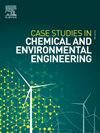Exploring the potential of Chlorella vulgaris for nutrient removal and biomass accumulation in palm oil mill effluent (POME): A sustainable and green technology approach
Q1 Environmental Science
Case Studies in Chemical and Environmental Engineering
Pub Date : 2025-08-06
DOI:10.1016/j.cscee.2025.101274
引用次数: 0
Abstract
The presence of excessive concentrations of essential elements in wastewater, particularly palm oil mill effluent (POME), contributes to environmental nuisances such as eutrophication, which depletes oxygen levels in water bodies and disrupts aquatic ecosystems due to high nutrient and organic loads. Herein, this study evaluates Chlorella vulgaris as a sustainable treatment route for nutrient removal from POME under three distinct cultivation conditions: (1) Control (CO)—900 mL synthetic growth medium and 100 mL Chlorella vulgaris culture, serving as a reference for microalgae growth under standard conditions without POME; (2) POME + Synthetic Growth Medium + Chlorella vulgaris Culture (PSC)—500 mL filtered POME, 400 mL synthetic growth medium, and 100 mL Chlorella vulgaris culture (POME-to-medium ratio of 2:1), designed to evaluate POME's potential to substitute conventional growth media; and (3) POME + Chlorella vulgaris Culture (PC)-900 mL filtered POME and 100 mL Chlorella vulgaris culture (POME-to-culture ratio of 1:1), evaluating the feasibility of using POME as the sole nutrient source for microalgae growth. Experimental results indicated that the PSC treatment recorded the highest nutrient removal efficiencies, with 94.64 % for total nitrogen (TN), 91.36 % for total phosphorus (TP), 92.31 % for nitrate (NO3−-N), and 90.91 % for ammonia-nitrogen (NH4+-N). The PC treatment exhibited slightly lower efficiencies, whereas the Control treatment showed the least removal effectiveness. Regression modeling was performed using MATLAB to predict optical density (OD) trends over cultivation time. Gaussian Process Regression (GPR) emerged as the best-performing model, with an R2 value of 0.984 and an RMSE of 0.608, demonstrating a strong correlation between OD and biomass accumulation. Linear Regression also demonstrated high accuracy (R2 = 0.978, RMSE = 0.707), confirming that Chlorella vulgaris growth can be effectively modeled over time. These statistical results reinforce the significant role of nutrient-enriched media in enhancing nutrient remediation and biomass accumulation. Hence, this study demonstrates Chlorella vulgaris as a promising candidate for POME bioremediation, paving the way for sustainable wastewater treatment and nutrient recovery technologies. The strong correlation between nutrient removal, biomass accumulation, and optical density growth highlights the potential of microalgal-based wastewater treatment systems in industrial applications.
探索普通小球藻去除棕榈油厂废水(POME)中营养物质和生物质积累的潜力:一种可持续和绿色的技术方法
废水中基本元素的浓度过高,特别是棕榈油厂废水(POME),造成了富营养化等环境危害,富营养化会耗尽水体中的氧气水平,并因高营养和有机负荷而破坏水生生态系统。本研究在三种不同的培养条件下,评价了普通小球藻作为去除POME中营养物质的可持续处理途径:(1)对照(CO) -900 mL合成生长培养基和100 mL普通小球藻培养液,作为无POME标准条件下微藻生长的参考;(2) POME +合成生长培养基+小球藻培养液(PSC) -500 mL过滤后的POME, 400 mL合成生长培养基,100 mL普通小球藻培养液(POME与培养基的比例为2:1),旨在评估POME替代传统生长培养基的潜力;(3) POME +小球藻培养液(PC)-900 mL过滤后的POME和100 mL普通小球藻培养液(POME与培养液的比例为1:1),评估POME作为微藻生长唯一营养源的可行性。实验结果表明,PSC处理的营养物去除率最高,总氮(TN)去除率为94.64%,总磷(TP)去除率为91.36%,硝态氮(NO3−-N)去除率为92.31%,氨氮(NH4+-N)去除率为90.91%。PC处理的去除率略低,而Control处理的去除率最低。利用MATLAB进行回归建模,预测光密度随培养时间的变化趋势。其中,高斯过程回归(Gaussian Process Regression, GPR)的R2值为0.984,RMSE为0.608,表现出OD与生物量积累的强相关性。线性回归也显示出较高的准确性(R2 = 0.978, RMSE = 0.707),证实了小球藻生长随时间的变化可以有效地建模。这些统计结果强化了富营养化培养基在促进养分修复和生物量积累方面的显著作用。因此,本研究表明,小球藻是一种很有前途的POME生物修复候选者,为可持续废水处理和养分回收技术铺平了道路。营养物去除、生物量积累和光密度增长之间的强相关性突出了基于微藻的废水处理系统在工业应用中的潜力。
本文章由计算机程序翻译,如有差异,请以英文原文为准。
求助全文
约1分钟内获得全文
求助全文
来源期刊

Case Studies in Chemical and Environmental Engineering
Engineering-Engineering (miscellaneous)
CiteScore
9.20
自引率
0.00%
发文量
103
审稿时长
40 days
 求助内容:
求助内容: 应助结果提醒方式:
应助结果提醒方式:


